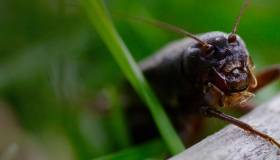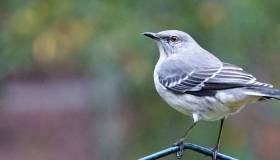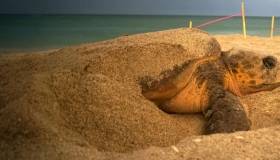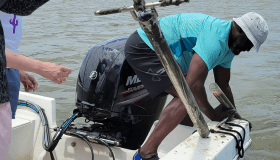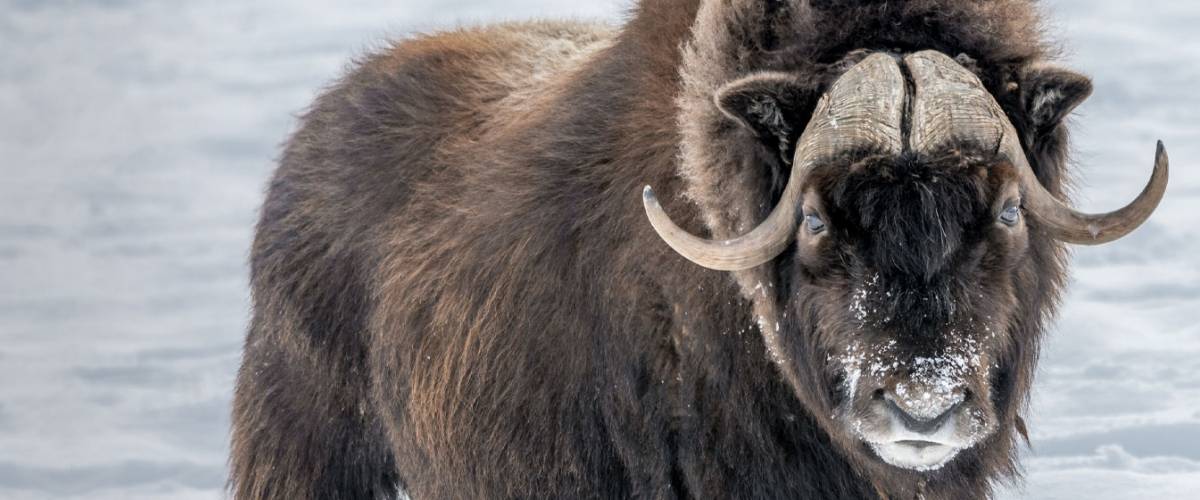
March 16, 2020 – 00:18 Kelly Diehl: Welcome to Fresh Scoop Episode 18, Muskoxen declines, a cautionary tale of climate change. I'm your host, Dr. Kelly Diehl, Morris Animal Foundation, Senior Director of Science and Communication. And today, we'll be talking to Dr. Susan Kutz, a Morris Animal Foundation funded researcher and veterinary parasitology. Dr. Kutz is an Associate Professor at the University of Calgary with an interest in wildlife parasitology. Fresh Scoop is the monthly podcast of Morris Animal Foundation, one of the largest non-profit foundations in the world dedicated to funding studies to find solutions to serious health threats to animals. In each episode, we'll feature one of the researchers we fund or one of our staff members discussing their work in advancing animal health. Whether you're practicing veterinarian, technician, or student, or just an animal-loving science geek, Fresh Scoop is the podcast for you. You can learn more about us at morrisanimalfoundation.org.
01:14 KD: So, okay, on to today's interview, and we're really excited today to welcome Dr. Susan Kutz. Dr. Kutz completed her Doctor of Veterinary Medicine degree at the Western College of Veterinary Medicine, University of Saskatchewan. After working as a veterinarian in the Canadian arctic for a few years, she returned to do a PhD in Wildlife Parasitology at the University of Saskatchewan. Following that, she was a post-doctoral fellow at the University of Alaska Fairbanks, where she studied host parasite associations in Beringia. She was a founding member of the new faculty of Veterinary Medicine at the University of Calgary and is an associate professor in the department of ecosystem and public health. So, Susan, thanks for joining us today.
02:02 Susan Kutz: Thank you. It's a pleasure to be here.
02:05 KD: So before we get into your work, can you tell us a little bit about yourself personally, and a little bit about your background?
02:14 SK: Sure. I grew up in Calgary, Alberta Canada, and it's a big city, but a lot of my upbringing was out in the countryside in foothills of the Canadian Rockies. That's really where I started to develop a love of nature and a love of wildlife. From there, I went on to university. I was going to be a biologist, and I was told there were no jobs.
[laughter]
02:37 SK: So I went on to veterinary school. And then from there, and I remember my interview clearly when I went to vet school, they said, "What do you want to be when you finish?" And I thought, "Well, I really don't know. I just know I want to work in the wildlife field." And at that time, there really weren't a lot of mentors in the field of wildlife veterinary medicine. And the jobs that were there were vets who were...they were service people working with biologists, so they would capture the animals. They would implant transmitters, but they weren't part of their real thinking research team. So, my vision of what I was going to end up being was really unclear. But then I went on, went to vet school, had some great jobs in the summers that were up in the Arctic, and just fell in love with the Arctic. Following that, I went off and did practice for a few years, and at some point, I got tired of squeezing anal glands...
[laughter]
03:31 SK: And decided to go back to school to pursue a graduate degree and looking at disease in wildlife of some sort. So yeah, that's really what got me to start graduate work was some time in the Arctic, a love of the Arctic, and then thinking I really wanted to make a difference and work at that conservation interface with free-ranging wildlife.
04:00 KD: Wow. And what drew you to focus on parasitology as another area of expertise?
04:11 SK: It wasn't intentional.
[laughter]
04:14 SK: I had no interest in parasites actually, but when I went back to school to... at first do a master's degree, because that's what I thought, that's all I wanted. I didn't want to become an academic. At the time, I was working in the Canadian North in Yellowknife in a practice there, and I wanted to come back and go to school and do work on disease in some large Arctic mammal and disease, something that kills them, something dramatic. And when I phoned down to the vet school to see what was available for graduate opportunities, they said, "Well, we don't have anything like that, but we've discovered a new lung worm in muskoxen,” and I said, "Well, well, that's nice, but I want to work on disease."
[laughter]
05:02 SK: I subsequently spoke with an amazing mentor of mine, Gary Wobeser, who is a wildlife pathologist in the vet school in Saskatoon. And he told me that really this is a really neat project. It's not often you get to work on a new genus of a parasite in a relatively charismatic wildlife species like muskoxen, and that parasite's really tie the world together. And so I did a little bit of a rethink, and my eyes were opened, and off I went to do graduate work on this parasite.
05:36 KD: We'll talk more about that, of course, when we talk about your research. And you alluded to your love of the Arctic, but why study it when we think often about parasites I think we think of hot, warm, moist areas? And why the Arctic in particular?
05:55 SK: I think one of the biggest reasons for studying parasites in the arctic is, the Arctic is a relatively untouched pristine environment, where there's not a lot of change that's been caused by people. And the biggest change there is climate change. So, the Arctic is changing, warming up at a rate that's two to three times at the global average, and this really puts a lot of pressure or changes on a system. So when we look at parasites up there, we can see that they're... that there's a lot that are very temperature dependent, and when we get temperatures that are one, two, three degrees above the normal, that dramatically changes their life cycles, it changes how they're transmitted, and it changes their impact on animals. And so if we just look at it as a model there, that we can call the Arctic as a model for understanding impact of climate change on disease in wildlife, and we can apply that to human systems as well. I think the second thing to me, and that's really dear to my heart, is that wildlife are just integral to the life of the indigenous peoples in the Arctic, they're important for their spiritual well-being, their mental well-being, their physical well-being, because people still very much depend on wildlife for food and also for their economic well-being.
07:17 SK: So it's a place where there's not a lot of jobs and wildlife provide the eco-tourism opportunities, and they provide income to communities. And so when there's such a close connection between people and animals, when animals end up diseased, it's a major concern for the people who depend upon them. So understanding the impact of parasites, of disease on the wildlife, working with people to understand that and conserve the wildlife is really... It's very attractive to me, and I think it's a very important place to be doing this because of the importance and connection that people have with wildlife.
07:57 KD: Right. That's a really good point I think that I don't often think of when we talk about loss of different species, and your project that the foundation funded, I know you do lots of different things involved. Muskoxen, which is you mentioned, are really charismatic species, but for those of us who don't know a lot about muskoxen, can you tell us a little bit more about them?
[chuckle]
08:22 SK: Sure. The Muskoxen are these amazing hairy beasts that are incredibly well-adapted to the Arctic. They are... they're taxonomically unique, so there is really nothing else in the world that it is closely related to them. And if we look at what is their closest relative, there is a goral and a serow. These live in Japan and in the Himalayas. They're completely different looking animals, but that is the closest living relative to the muskox. So that in itself make these animals an incredibly important and important to conserve. They are...we call them the Ice Age relics. They have survived over time. They've thrived in the Arctic. They thrived in the Arctic up until about the early 1900s.
09:12 SK: They have this incredible undercoat. It's called qiviut, and it is grown and replaced every year, and it is the warmest fiber known to man. It’s the warmest natural fiber in the world. It's worth a fortune, so people do collect it. They make beautiful garments out of it, and they sell at incredibly high prices, and it's because the way this fiber is it's just so warm which, of course, makes sense being an Arctic beast. The other thing about them is their metabolism is quite interesting, and that they really don't do a lot in the wintertime. They eat a little bit, they move around a bit, but they are just so well-adapted to times of scarce food and cold, and so they can cope with that.
10:01 KD: That is really cool. So to move into a little bit more with your project, but to build on what you just were talking about, how has climate change affected muskoxen?
10:13 SK: That's a very good question. And as a scientist, we're always cautious on what we say.
10:20 KD: Yeah, no.
10:22 SK: But [chuckle] these animals are very well-adapted to very cold conditions. This undercoat that they have that they grow keeps them very warm which means when temperatures get unusually warm, they suffer, they suffer from heat stress. There was some work actually done in Norway with some muskoxen that had been introduced to Norway. Entering an unusually warm period, these animals that were panting, they ended up with pneumonia just from the constant stress and the heat. So that's probably one of our best examples of direct heat stress affecting them. The other thing... And I guess when we look at the Arctic, and we look at loss of sea ice, when that sea ice is lost, it's like this giant ice cube disappearing, and that ice cube previously cooled the mainland, the islands, and so kept those temperatures cooler. But now, we see periods of ice-free... A longer ice-free season in the Arctic, and we see these animals being exposed to more heat probably...
11:32 SK: Well, I guess there's a couple of things. One, we do know that one of the diseases that muskoxen get is expanding its range further north, and that's actually the first parasite that I ever studied. It's called Umingmakstrongylus pallikuukensis. It was named in Inuinnaqtun with umingmak meaning muskox and pallikuuk, the location it was first discovered. That lungworm is unique to muskoxen, and we have tracked that expanding its range about 300-350 miles further north since the early 2000s, and that's directly related to temperature. So animals who previously were not infected are now infected, and animals in the corridor range where it always has been, have higher infection levels.
12:21 KD: I never thought about the actual facts, direct effects of heat, because I think we talk a lot about the secondary effects like you mentioned, spread of disease, so basically it's like the equivalent of locking your dog in a car on a hot day as we're subjecting these individuals to temperatures that they're clearly not designed for, and I appreciate you pointing that out. So let's talk a little bit about your proposal now, and can you describe briefly your project and your hypothesis?
12:21 SK: Sure. We have two different projects that we've been working on with Morris Animal Foundation. The one that is most directly related...well, they're both related to climate and climate change and disease. One of them is to understand whether or not we can use qiviut, which again that's assistance undercoat that the muskoxen grow every year, as an indicator of stress in muskoxen. So we do think with all the changes in the Arctic, the levels of stress in the animals are likely increasing and that stress can be because of direct heat, it can be because of changes in vegetation, it can be changes in the timing of when plants become available and when they go into senescence, it can be because of changes in other species that are up there. So our goal is to develop a technique that can be used to track the health of the animals over time and is a relatively easy way to do it, either non-invasively. So this wool is shed and it's caught up on the bushes and you can collect it from the tundra. Or working in partnership with subsistence indigenous hunters. When they get an animal for food, they collect some of this fur, and we can test that and look at stress levels.
14:18 SK: So, one of my students has been working on this, and what she's been doing is looking at, using captive animals up in Fairbanks, Alaska to test whether or not when muskoxen stressed, is that signal in the hair, is it in that qiviut. And she spent a lot of time working with the captive animals there trying to determine that, and in fact, through a series of quite intricate studies, experiments she's being able to show that when the animals are stressed that signal shows up in their hair. Now, what she's doing is applying that to the wild populations. And by looking at the qiviut of these muskoxen from different populations, different ages, different sexes of animals, she's being able to see that there is a difference in different geographic locations. There's a difference in between males and females and there's also been a difference over time with the signal of increasing levels of stress based on the qiviut.
15:20 KD: So did anything surprise you from this work?
15:24 SK: Let me think here. What's surprises? I guess one of the things that didn't necessarily surprise us but was very important was that we've seen declining muskox populations over time in this area that we're studying with animals seeming sicker, poor calf recruitment and just fewer animals are skinny, they've got these non-descript diseases, things like that. And that was really picked up in the qiviut over time. So from year to year with this increasing levels of stress. So did that surprise us? Maybe, maybe not, it sort of reaffirm the fact that yes, this may be a good indicator that we can use to track animals over time and start to make predictions about how the populations may be doing.
16:10 KD: Right and I think you mentioned, one of the things that's really attractive about looking at stress in this way is you're not capturing animals and drawing blood from them. When we think of classically looking for cortisol levels or other measures of stress, I think this is a great way of doing that. Could you, speaking of that, talk a little bit in more detail about your methodology obviously you were collecting samples of hair, but can you detail for folks a little what you were looking at?
16:47 SK: Sure, so I'll talk about first the captive work that was done, and then the wildlife work if that's helpful.
16:54 KD: Yeah, sure.
16:55 SK: Okay, so working with the university Alaska, Fairbanks, where there is a captive muskoxen that's been there for decades now. Juliet went and she had a group of animals that were control, a group of animals that were her treatment animals and they were given an injection, the treatment animals an injection of ACTH, which stimulates cortisol production. And that happened weekly over five weeks. And at the start of it, she shaved patches of hair, and then at the end of it, she tested the hair that had re-grown and by doing that she was able to determine if that injection was reflected in the qiviut as increased hair cortisol. And sure enough, that's what she did find is with the experimental animals, compared to the control animals, there was a definite increase. She also actually did some work looking at the stability of that because when we want to take that and translate that to the wild populations, we need to know that in fact the cortisol remain stable in the hair over time.
18:07 SK: So, subsequently that the experiment happened in the summertime, and then subsequently she retested the animals over the winter when the hair had stopped growing but to ensure that in fact that that signal was still there, and it would be a reliable way of understanding the stress levels in the animals. The one thing she did find and this is quite important is that in the end tested whether or not that shed qiviut had the same level as the qiviut that was still on the animal, and she found there was a little bit of an increase in the shed qiviut. It was consistent across animals, but it was there. And that just tells us that we do need to be a little bit careful how we interpret that. It's still very valid, but we can't compare animals at the end of the... In the springtime when they're about to shed the qiviut compared to the fall. We just need to know when we're looking at a population, we need to compare spring-to-spring and fall-to-fall. And so very important information that often doesn't get done. We often do this work with wildlife, and we make these assumptions, and we don't have that underlying experiment that really teases out some of these details and ensures that we interpret the wildlife information appropriately.
19:31 KD: So that makes me think of another question that popped to my head which is, how can a study like this, not only how muskoxen, but maybe translate to other Arctic animals?
19:47 SK: Yeah, I think it can, in many ways. The detail that she has done this in, I don't think that anybody else has done work to this detail with captive, large ungulates. There's been a few small studies, smaller sample sizes, things like that, but nobody's really looked in as much detail and validated the use of hair cortisol as a measure of stress. Most of the studies have been just...they've been cross-sectional wildlife and correlational; so you see some stress, you look at other things, and you say, "This is causing it." But this process of actually teasing out the details hasn't been done to the same extent. So I think the model that she has done, the process that she has taken is one that people can take and apply to other species and ensure there's rigor in the interpretation of results, ultimately, from the wildlife.
20:49 SK: I suppose the other thing is in the Arctic, the other large ungulate species in the Arctic is caribou. And caribou and muskoxen share much of the same range, they share a lot of the same challenges. They do have slightly...they have different life histories, they graze a little bit differently; caribou migrate, muskoxen don't. But if we can understand muskoxen and what are the stressors for them, a lot of those same stressors are going to be affecting caribou. So just the information that she can get from the muskoxen can also help to shed light on caribou, and then hopefully at some point, somebody does these studies in as much detail for caribou on hair cortisol. People are doing work with hair cortisol, but they haven't done the experimental work to really validate it as well.
21:35 KD: Right. And that's really helpful, your explanation, because I know we occasionally see projects coming through Morris Animal Foundation looking at hair samples in small animals too for the same idea is, it could be a more easily obtained measure of health, and I think often very ignored for a long time as an important sample. So what's next for you guys, as far as what are your research attention, not just muskoxen, but Arctic species in general?
22:12 SK: Yeah. Well, we have a lot on the go. This project itself really grew out of the fact that what we want to do is develop these systems for ongoing, effective and standardized wildlife health surveillance. The Arctic...it's huge. There are very few people that live there, and so we need to think about novel ways of understanding wildlife populations. The way that we have done that, we work very closely with biologists who do the population surveys, see what's out there. But that information is very limited, surveys happen...in Canada, they only happen every five or 10 years, because we don't have that much money. And by that time, a population can increase or be on a steep decline before it's ever detected with population surveys.
23:07 SK: So our work has been really to work with communities across the Arctic and with subsistence centers; so these are people, indigenous people, who are going and getting caribou or muskoxen for food to feed their families, because the prices of getting meat up there are outrageous, grocery store prices are crazy. So by working with people who are already harvesting animals for food, we get all sorts of samples from those animals. The hair is one, which we look for cortisol. But we're also looking at trace minerals, which are an essential for animals to grow, develop, mount effective immune systems, etcetera. We look at infectious disease; so we've got a technique that we've been using now for several years using filter paper for blood collection, and this is something that somebody could do at minus 40, as opposed to collecting it in a test tube and trying to keep a test tube from freezing and trying not to have it break.
24:09 SK: We collect the hair, we collect leg bones, look at marrow fat, and look at teeth. And so this strategy has served as a really effective way of getting a huge amount of information on animals that is not gathered through your traditional population surveys. And what we can do with this, is we use it as an early detection of change. So we do the sampling, but we also interview people to say, "How are the animals this year?" And we can tell if overall the body condition is going down, we can suspect that next year's not going to be a good year. We're hoping with this hair cortisol, which our next step is to actually look at the hair cortisol in the wild animals compared to their condition and compared to the population trends. With that, that can be an indicator of, "Hey, the population's not doing so well, we should do something about it now instead of waiting another five years for the next population survey." So this is a real key piece of what we are doing. We continue to do work with Morris to find studies, to find areas. So one of the key things that Morris Animal Foundation funded us for several years ago was looking at a new bacteria, new to our knowledge in the Arctic bacteria called Erysipelothrix rhusiopathiae, that bacteria was responsible for widespread mortality in muskoxen.
25:42 SK: It was the first time we ever detected it in the Arctic, didn't know why it had happened, but there was literally thousands of muskoxen that had died from that. We're continuing to work on that now, and we have...through Morris, we were able to look at that very broadly, right across Canadian and Alaskan Arctic to see if it's present in muskoxen, is it present in Caribou, and how long has it been present? So, we know that that has been circulating in these animals now for as long as we've got blood samples, going back archive blood samples. But we still don't understand why it had such a severe impact on muskoxen.
26:21 SK: So, a big piece of what we're doing next on that is looking at this strain that we've isolated from these mortality events and trying to figure out is, are there particular virulence factors in this strain that has caused so much problems? We're looking at environmentally. Are there other hosts? Are lemmings playing a role in this that when... because they can carry it as well and is that something where muskoxen or caribou are getting increased exposure. Is it associated with stress? Which brings back our hair qiviut, or qiviut cortisol levels. Is it associated with unusual environmental conditions? So that's a big area that we're really trying to explore right now and better understand.
27:07 KD: That sounds really interesting. I think there are lots of people who listen, and I feel the same way. It can be very discouraging when we listen to people talk about the impacts on the animals that we all love, and it can be paralyzing. So if you could give a message to folks listening. What can people do and not just give up or be sad. What can people do to help?
27:36 SK: Yeah. I guess a few things. Number one, climate change is happening. It's having major impacts. It's affecting the health and well-being of Arctic species and species everywhere. And I think there's no doubt about that, and we have to just stop saying, "This isn't happening." And it is and it is important. When it comes to "What can we do," we need to get creative. We have to think outside of the box. And one of the big challenges in the Arctic that we're going to have is with ice-free seasons. There will be more industrial development. The Arctic is so rich in minerals and resources. So, we need to think very carefully about how that's done and have strategies in place that ensure that the wildlife have access to the lands that they need. And we need to be thinking forward of what will they need in the future. So protecting something today is not necessarily what they're going to need in the future.
28:38 SK: On an individual basis, we can do a lot. And I think it is overwhelming and people think, "Oh, there's nothing I can do." But I think if we start at an individual basis and talk to our friends and get them thinking at an individual basis, "What can I do to cut down my carbon emissions? What can I do to put a bit of pressure on the politicians to do something? What can I do to change things in my community?" There have been studies done out there that if we stop the global warming to one and a half degrees above average compared to two degrees, what difference does that make? And it does make a big difference in various different systems. So, yes, it's warming, it's on that trajectory, but anything that we can do now will help to dampen that we hope.
29:23 KD: Well, thanks, Susan, and thanks for all you and your group do to address this really important problem. And we really appreciate all the important work you and your group are doing to save animals in the Arctic and educate folks more about what we can do to be helpful. And so, thanks for joining us so much today. I'm glad we had a chance to chat.
29:48 SK: Thank you, Kelly. It's been a real pleasure. And a really big thanks to Morris Animal Foundation for the support that they've provided that have made these studies possible.
29:57 KD: Well, we appreciate all that you guys do. So thank for being with us, Susan.
30:02 SK: Thank you, Kelly, it's been a pleasure.
30:04 KD: And so that does it for this episode of Fresh Scoop. Once again, thanks to Dr. Susan Kutz for joining us. We'll be back with another episode next month that we hope you'll find just as informative. And we know that the science of animal health is ever changing and veterinarians need cutting-edge research information to give their patients the best possible care and that's why we're here. So, you can find us on iTunes, Spotify, Google Podcasts, and Stitcher. And If you liked today's episode, we'd sure appreciate if you could take a moment to rate us and that will help other folks find our podcast. And to learn more about Morris Animal Foundations work again, go to morrisanimalfoundation.org. There you'll see just how we bridge science and resources to advance the health of animals. And you can also follow us on Facebook, Twitter, and Instagram. I'm Dr. Kelly Diehl, and we'll talk soon.

